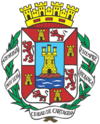Cartagena, Spain
| Cartagena | |||||||
|---|---|---|---|---|---|---|---|
| Municipality | |||||||
Cartagena | |||||||
| |||||||
| Motto: Muy noble, muy leal y siempre heroica ciudad de Cartagena | |||||||
 Cartagena Location in Spain | |||||||
| Coordinates: 37°36′N 0°59′W / 37.600°N 0.983°WCoordinates: 37°36′N 0°59′W / 37.600°N 0.983°W | |||||||
| Country |
| ||||||
| Autonomous community |
| ||||||
| Province | Province of Murcia | ||||||
| Comarca | Campo de Cartagena | ||||||
| Judicial district | Cartagena | ||||||
| Founded | 227 BC | ||||||
| Government | |||||||
| • Mayor | José López Martínez (2015) (MC Cartagena) | ||||||
| Area | |||||||
| • Total | 558.08 km2 (215.48 sq mi) | ||||||
| Elevation | 10 m (30 ft) | ||||||
| Highest elevation | 50 m (160 ft) | ||||||
| Lowest elevation | 0 m (0 ft) | ||||||
| Population (2012) | |||||||
| • Total | 216,655 | ||||||
| • Density | 390/km2 (1,000/sq mi) | ||||||
| Demonym(s) | Cartageneros | ||||||
| Time zone | CET (UTC+1) | ||||||
| • Summer (DST) | CEST (UTC+2) | ||||||
| Postal code | 302xx and 303xx | ||||||
| Dialing code | (+34) 968 | ||||||
| Website | Official website | ||||||
Cartagena (Spanish pronunciation: [kartaˈxena]; Arabic: Al-Qartājanna قرطاجنة, Latin: Carthago Nova) is a Spanish city and a major naval station located in the Region of Murcia, by the Mediterranean coast, south-eastern Spain. As of January 2011, it has a population of 218,210 inhabitants[1] being the Region’s second largest municipality and the country’s 6th non-Province capital city. The metropolitan area of Cartagena, known as Campo de Cartagena, has a population of 409,586 inhabitants.
Cartagena has been inhabited for over two millennia, being founded around 227 BC[2] by the Carthaginian Hasdrubal the Fair[3] as Qart Hadasht, the same name as the original city of Carthage. The city had its heyday during the Roman Empire, when it was known as Carthago Nova (the New Carthage) and Carthago Spartaria, capital of the province of Carthaginensis. It was one of the important cities during the Umayyad invasion of Hispania, under its Arabic name of Qartayannat al-Halfa.
Much of the historical weight of Cartagena in the past goes to its coveted defensive port, one of the most important in the western Mediterranean. Cartagena has been the capital of the Spanish Navy's Maritime Department of the Mediterranean since the arrival of the Spanish Bourbons in the 18th century. As far back as the 16th century it was one of the most important naval ports in Spain, together with Ferrol in the North. It is still an important naval seaport, the main military haven of Spain, and is home to a large naval shipyard.
The confluence of civilizations as well as its strategic harbour, together with the rise of the local mining industry is manifested by a unique artistic heritage, with a number of landmarks such as the Roman Theatre, the second largest of the Iberian Peninsula after the one in Mérida, an abundance of Phoenician, Roman, Byzantine and Moorish remains, and a plethora of Art Nouveau buildings, a result of the bourgeoisie from the early 20th century. Cartagena is now established as a major cruise ship destination[4] in the Mediterranean and an emerging cultural focus.
It is the first of a number of cities that eventually have been named Cartagena, most notably Cartagena de Indias (Cartagena of the Indies) in Colombia.
Geography and climate
Geography and relief
The city of Cartagena is located in the southeastern region of Spain in the Campo de Cartagena. The Cartagena region can be viewed as a great plain inclined slightly in the direction NW-SE, bordered at the north and the northwest by pre-coastal mountain ranges (Carrascoy, El Puerto, Los Villares, Columbares and Escalona), and at the south and southwest by coastal mountain ranges (El Algarrobo, La Muela, Pelayo, Gorda, La Fausilla y Minera, with its last spurs in Cape Palos). The dominant geology of the region is metamorphic (slate, marble) and sedimentary (limestone).
The city is located just at the end of the new AP-7 motorway. The following villages are part of Cartagena municipality: La Azohía, Isla Plana, Los Urrutias and Los Nietos.
The Old Town is limited by five small hills (Molinete, Monte Sacro, Monte de San José, Despeñaperros and Monte de la Concepción) following the example of Rome. In the past, there was an inner sea between the hills called the Estero that eventually dried up. On this site, the "Ensanche" (Expansion or New Town) was built at the beginning of the 20th Century.
The urban area is delimited or crossed by several watercourses, some of which go deep into the urban network during a large part of their courses.
Climate
Cartagena has a hot semi-arid climate. Its location near the ocean moderates the temperature, and annual precipitation typically does not surpass 380 mm (15 in). The annual average temperature goes up to around 20.4 °C (69 °F), making it the warmest city in continental Europe. The coldest month is January, with an average of 13.7 °C (57 °F). In August, the warmest month, the average temperature is 28.7 °C (84 °F). The wind is an important climatic factor in the region.
| Climate data for Cartagena | |||||||||||||
|---|---|---|---|---|---|---|---|---|---|---|---|---|---|
| Month | Jan | Feb | Mar | Apr | May | Jun | Jul | Aug | Sep | Oct | Nov | Dec | Year |
| Record high °C (°F) | 25.8 (78.4) |
28.2 (82.8) |
30.5 (86.9) |
34.8 (94.6) |
37.3 (99.1) |
39.6 (103.3) |
43.8 (110.8) |
42.1 (107.8) |
38.7 (101.7) |
34.1 (93.4) |
30.8 (87.4) |
24.6 (76.3) |
43.8 (110.8) |
| Average high °C (°F) | 18.2 (64.8) |
19.3 (66.7) |
20.4 (68.7) |
22.0 (71.6) |
24.3 (75.7) |
28.4 (83.1) |
33.5 (92.3) |
33.1 (91.6) |
30.0 (86) |
27.5 (81.5) |
22.7 (72.9) |
19.6 (67.3) |
24.9 (76.8) |
| Daily mean °C (°F) | 13.7 (56.7) |
14.6 (58.3) |
15.4 (59.7) |
17.3 (63.1) |
20.1 (68.2) |
24.0 (75.2) |
28.2 (82.8) |
28.7 (83.7) |
25.7 (78.3) |
22.8 (73) |
19.0 (66.2) |
15.1 (59.2) |
20.4 (68.7) |
| Average low °C (°F) | 9.1 (48.4) |
9.9 (49.8) |
10.4 (50.7) |
12.6 (54.7) |
15.8 (60.4) |
19.7 (67.5) |
22.9 (73.2) |
24.3 (75.7) |
21.5 (70.7) |
18.1 (64.6) |
15.3 (59.5) |
10.6 (51.1) |
15.9 (60.6) |
| Average precipitation mm (inches) | 28 (1.1) |
23 (0.9) |
51 (2.0) |
69 (2.7) |
15 (0.6) |
28 (1.1) |
0.3 (0.01) |
5 (0.2) |
48 (1.9) |
51.1 (2.01) |
30 (1.2) |
30 (1.2) |
396 (15.6) |
| Source #1: AEMET
"Atlas Climático de Murcia". AEMET. 2014. | |||||||||||||
| Source #2: Various sources: Atlas de Murcia,[5] University of Murcia[6] and Weatherbase[7] | |||||||||||||
Environment
Despite the intense mining, tourist and industrial exploitation that the area has suffered for centuries, the territory around Cartagena city hosts an extraordinary natural wealth and diversity, with a large number of botanical endemic species. Part of its area is subject to different levels of legal protection.
Flora

Cartagena’s coastal mountains have a concentration of one of the largest botanical biodiversities of the Iberian Peninsula. European and African species are both present, as well as a number of remarkable Ibero-African species, which are only found on the southern coasts of Spain (mostly in the provinces of Murcia and Almería) and North Africa. Among these, there stands out the tetraclinis articulata or Sandarac (sabina mora o ciprés de Cartagena—literally Cartagena's cypress in Spanish) endemic to Morocco, Algeria, Tunisia, Malta, and Cartagena, growing at relatively low altitudes in a hot, dry subtropical Mediterranean climate. Some species are seriously endangered like the siempreviva de Cartagena (Limonium carthaginense), the rabogato del Mar Menor (Sideritis marmironensis), the Zamarrilla de Cartagena (Teucrium carthaginense), the manzanilla de escombreras (Anthemis chrysantha), the garbancillo de Tallante (Astragalus nitidiflorus) and the jara de Cartagena Cistus heterophyllus carthaginensis ).
Fauna
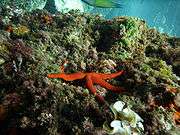
Between the animal species it is necessary to emphasize some threatened or endangered ones like the peregrine falcon, the Eurasian eagle-owl, the golden eagle and the Bonelli's eagle, the Spur-thighed Tortoise, the Greater Horseshoe Bat and, especially, the Spanish toothcarp, an endemic fish to south-eastern Spain. In addition, the presence of the common chameleon (the only chameleon in Europe) has been documented for about 30 years, although it is not clear if it is a native or introduced species. Besides the previous ones, there are also present the greater flamingo, the red fox, the European rabbit, the European badger, the Beech marten, the common genet, the wildcat and the wild boar.
Protected areas
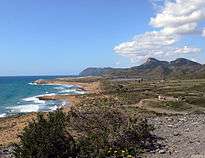
- Mar Menor, a salty lagoon separated from the Mediterranean sea by a sand bar 22 kilometres (14 miles) in length and with a variable width from 100 to 1,200 metres (328 to 3,937 feet). It has a surface area of nearly 170 km2 (66 sq mi), a coastal length of 70 km (43 mi), and warm and clear water with relatively high salinity, which does not exceed 7 metres (23 feet) in depth. It belongs to four municipalities, including Cartagena. In 1994, it was included on the list of the Ramsar Convention (nº706) for the conservation and sustainable utilization of wetlands. It is also one of the Specially Protected Areas of Mediterranean Importance (SPAMI) by the United Nations. Its five volcanic islands (Perdiguera, Mayor or del Barón, del Ciervo, Redonda and del Sujeto) just like El Carmolí and San Ginés hills, the Hita and Amoladora beaches, the Lo Poyo salt marsh and the salt mines of Marchamalo are protected as well.
- Calblanque, Monte de las Cenizas and Peña del Águila, declared a Natural Park and Site of Community Importance (SCI).
- Sierra de la Muela, Cabo Tiñoso and Roldán mountain, Natural Park, Site of Community Importance and Special Protection Area (SPA).
- Sierra de la Fausilla, Special Protection Area
- Islands and Islets of the Mediterranean coast, including Grossa Island (belonging to the municipality of San Javier, Hormigas Islands, Palomas Islands and Escombreras Islands, some of them also designed as Special Protection Area.
History
Ancient history

The town was originally named Mastia. Possessing one of the best harbors in the Western Mediterranean, it was re-founded by the Carthaginian general Hasdrubal in 228 BC as Qart Hadasht ("New City"), identically named to Carthage, for the purpose of serving as a stepping-off point for the conquest of Spain. The Roman general Scipio Africanus conquered it in 209 BC and renamed it as Carthago Nova (literally, New New City) to distinguish it from the mother city. Julius Caesar gave the town Latin Rights, and Octavian renamed it in his honor as the colony Colonia Victrix Iulia Nova Carthago or Colonia Vrbs Iulia Nova Carthago (C.V.I.N.C.) depending on the source. The city was very relevant both in the Carthaginian and the Roman conquest of the Iberian Peninsula. In 298 AD, Diocletian constituted a new Roman province in Hispania called Carthaginensis and settled the capital in this city. It remained important until it was sacked by the Vandals in 435 AD.
During the Roman period, it was the site of major silver mines, yielding a daily revenue of 25,000 drachmae. It was known also for the production of garum, a fermented fish sauce, and for esparto grass[8] which granted it a new name, Cartago Spartaria.
Middle Ages
The demise and fall Western Roman sovereignty caused the city to go into decline. It was occupied successively by the Vandals (409–425), the Visigoths (425–551 and 624–714) and the Eastern Romans (551–624), who made it the capital of Spania (the Byzantine Empire's westernmost province). Cartagena was re-conquered by the Visigoths, who held it until the Muslim conquest in 714 AD, when it was called Qartayannat-al-Halfa. It was subsequently ruled by the Umayyads (714–756), the Caliphate of Cordova (756–1031), the Taifa of Denia (1031–1076), the Taifa of Saragossa (1076–1081), the Taifa of Tortosa (1081–1092), the Almoravids (1092–1145), the Almohads (1145–1229) and the Taifa of Murcia (1229–1245). King Alfonso X of Castile (Alfonso the Wise) conquered Cartagena in 1245; he reestablished Christian rule and the Bishopric of Cartagena. In 1270, Alfonso created the Order of Santa María de España for the naval defense of the Crown of Castile and established its headquarters in Cartagena. In 1296, Cartagena was annexed to the Kingdom of Aragon as the Reconquista focused on the remaining Muslim kingdom, Granada, which fell in 1492. Cartagena entered a period of great decadence and decay, despite a short economic revival in the 16th century, because Spain's colonial activities used ports to the west. Cartagena didn’t fully recover until the 18th century, when it became a leading naval port in the Mediterranean.
Modern history
On 3 September 1643, the French led by Grand Admiral Jean Armand de Maillé-Brézé defeated most of Spain's fleet here.
In 1728, Cartagena became the capital of the Spanish Navy's Maritime Department of the Mediterranean and the city was heavily fortified with the construction of a modern Castle in the place of a former Moorish Kasbah, several barracks and a huge arsenal. In a relatively short period of time, the population of the city grew from around 10,000 to 50,000 inhabitants.
In 1757, during the Seven Years' War, a French naval force was forced to take shelter in the port. A squadron under Duquesne sent to reinforce them was attacked and defeated by a British squadron under Henry Osborn at the Battle of Cartagena.
In 1873, the city established an self-governing government and become the center of the Cantonal Revolution. Governmental forces besieged the city for several months until they surrendered.
During the Spanish Civil War (1936–1939), Cartagena was the main base of the Spanish Republican Navy and one of the primary strongholds of the Republican Government. It held out against the forces of General Francisco Franco longer than any other city in Spain, being the last of its cities to surrender. The city saw its industrial activity increased during the 1950s, resulting in more prosperity and this trend continued until a general decline in manufacturing throughout Europe in the late 1980s and early 1990s.
Present
At the moment, Cartagena comprises part of the autonomous community of the Region of Murcia, and is the seat of the Regional Assembly of Murcia. It is also capital of the maritime province of Cartagena, which was granted by the Royal Decree of 5 October 1607 under the reign of Philip III.
Demographics
According to the Municipal census, as of January 2011, Cartagena has 218,210 inhabitants, ranking 24th in Spain in terms of population (and 6th among the non-capitals). 182,021 people live in the urban area and 39,840 in the several satellite quarters. According to the official population data, 14.73% of the municipality's population had a foreign nationality.
Its metropolitan area, which includes the municipalities of La Unión, Fuente Álamo de Murcia, Los Alcázares, San Javier, Torre Pacheco, San Pedro del Pinatar and Mazarrón, has a total of 390,983 inhabitants.
- Demographic evolution of Cartagena since 1842
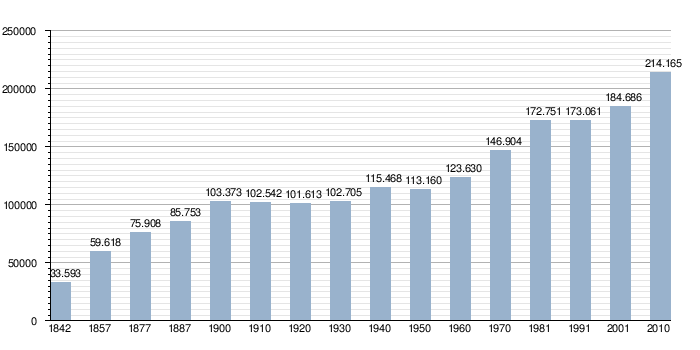
Nota: The municipal extension varies from the 1857 census and the previous one because of the annexion of La Palma and La Unión segregated.
Main sights
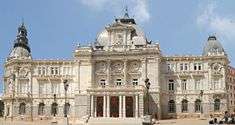
Thanks to its strategic position on the Mediterranean, Cartagena has been inhabited by many different cultures, which have left their mark on its rich cultural heritage during a glorious and turbulent history.
The “Cartagena, Port of Cultures” initiative was created to allow visitors to enjoy a wide range of activities and visits, discovering the cultural wealth and rich history of the city. It’s one of the several projects to energize the tourist possibilities of this potential major cultural destination, frequently overshadowed by the mass-tourism due to the proximity of several holiday resorts, and the refinery and the industrial development, which gave a bad reputation to the city because of pollution, now fortunately eradicated.
Archaeological sites

Although there are some ruins from the Carthaginian ages, like the remains of the Punic rampart (built in 227 BC with the foundation of the city), most of its oldest monuments date from the time of the Roman Empire when Cartagena flourished. The archaeologist Blanca Roldan studied this Punic Rampart and other punic remains, specially in the Molinete Hill. Among its numerous Roman remains, the recently restored Roman theatre of Carthago Nova is prominent and is one of the city landmarks. Its building works started at the end of the 2nd century BC. The Roman Theatre museum was recently officially opened for the first time. In Roman Republican Times, the mines near Cartagena provided Silver and Lead to all the Roman Empire.
Other Roman remains can be found on several buildings and centres for interpretation, including the Roman colonnade, the House of Fortune, the decumanus and the Augusteum. The Torre Ciega was built by the Romans for burials rights; it formed part of the Necropolis.
The Roman Amphitheatre (1st century AD) lies where the now abandoned Bullring was built, but only some of the surrounding walls and part of the rooms under the stands are still visible.
Besides the Roman heritage, the archaeological sights include the remains of the Santa María la Vieja Cathedral, which was irreversibly destroyed during the Spanish Civil War. It dates from the end of the 13th century. A decorated floor of a Roman house of the 1st century BC can be found in the crypt.
A Byzantine rampart can be found, closer to the Roman theatre and the Cathedral.
The Concepción Castle (now Centre for Interpretation of the History of Cartagena) was reconstructed in the 13th century using large structures from the Amphitheater. Apart from the Roman Theatre museum, there are also two important archaeological museums: the Municipal Archaeological museum and the recently opened Arqua (National Museum of Maritime Archaeology).
Baroque and Neo-classical buildings
The Campus Muralla del Mar, an old military hospital, was one of the first works carried out after the transformation of the city into the main Spanish naval base in the Mediterranean, and is now the seat of the Polytechnic University. In the vicinity, there is the Autopsy theater, which is where anatomy classes used to be given. The touristic rehabilitation offers the patrimonial interpretation of the nearby buildings at the time of its construction.
These buildings and several other baroque or neo-classical buildings demonstrate the military importance of Cartagena. These include the Charles III rampart, the Castillo de San Julián, the Arsenal, the Midshipman's Barracks (academy and naval barracks), the Naval Headquarter Palace (built in 1740 and subsequently reformed) and the Artillery Headquarters, which also houses the Military Museum. Among the baroque or neo-classical Churches in Cartagena are El Carmen, Santo Domingo and Santa Maria de Gracia.
The austere façade of the Molina House hides the Centre of Arts and Craft.
Modernist and eclectic buildings
Cartagena is home to numerous Art Nouveau buildings from the early 20th century, when the Bourgeoisie settled down in the city due to the growth of the local mining industry. These buildings include the City Hall, the Grand Hotel, the Casino (all of them among the city's landmarks).
The Railway Station has some outstanding iron doors and columns on the façade, and inside can still be seen the original ticket office, doorframe, ceiling and the lamps. Other modernist or eclectic houses include the Clares House, the Aguirre Palace (which houses the Regional Museum of Modern Art), the Cervantes House (relatively big in comparison with other modernist buildings), the Llagostera House, the Pedreño Palace, the Dorda House, the Zapata House and the Urban Expansion Company House.
Several charming lively streets cover this area, such as Calle Mayor (the High Street), the major pedestrian and commercial street of the city, full of boutiques and bars with typical "tapas", Carmen Street, the Puertas de Murcia street and many more.
The Caridad church is one of the most important churches in the city, since it is dedicated to the patron saint of Cartagena. The interior is dominated by a dome, similar to the Roman pantheon of Agrippa. There are also several outstanding sculptures by the famous murcian sculptor Francisco Salzillo and his school.
Contemporary sights

The Civil War shelter-museum lies on the galleries excavated out the Concepción hill (where is the Castle) to serve as air-raid shelters during the Spanish Civil War. Many naval and military attractions belong to this route, such as the Naval Museum and the world-famous Peral Submarine invented by Isaac Peral (born in Cartagena) that was launched in 1888 as one of the first U-Boats ever. It was shown on Cartagena's promenade until its move to the Naval Museum after a full restoration.[10]
The Monument to the Heroes of Santiago de Cuba and Cavite (1923) is a war memorial erected in honour of the Spanish sailors who died in combat with the US Navy in waters off Cavite and Santiago off the Philippine and Cuban coasts.
Other attractions include the Lift-Gangway near the former Bullring and the Concepcion hill, the Regional Assembly (the Parliament of the Region of Murcia) which façade has architectural influences of the Renaissance while maintaining a modernist air (typical in the Levant), and the Carmen Conde-Antonio Moliner museum that reconstructs the atmosphere in which these poets from Cartagena created part of their important works.
Beaches
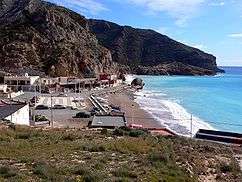
Although the city itself is only a port, within the city limits lies part of La Manga del Mar Menor (the other part belonging to the municipality of San Javier) which encompasses the Mar Menor. Cartagena also includes part of the Murcian Mediterranean Coast. Cartagena holds the distinction of being the Spanish city with the most beaches (10) certified "Q for Quality" by the ICTE (Instituto para la Calidad Turística Española). These beaches are: Cala Cortina, Islas Menores, Playa Honda beach, Mar de Cristal, Cala del Pino, Cavanna beach, Barco Perdido beach, El Galúa beach, Levante beach and La Gola beach.
El Portús beach is adjacent to the naturist camping site, nude bathing is practised on this beach.[11]
Notable people
- Hasdrubal the Fair (c. 270 BC – 221 BC), military leader and general
- Hannibal (247 BC - 183 BC), military commander
- Liciniano de Cartagena (554-602), archbishop of the Diocese Cartaginense
- Hazim al-Qartayanni (1184-1211), poet
- Juan Fernández (1528-1599), mariner and explorer of the Pacific Ocean and Polynesia
- Sebastián Raval (1550-1604), composer
- Antonio de Escaño (1750-1814), army and naval officer
- Baltasar Hidalgo de Cisneros (1755-1829), naval officer
- Isidoro Máiquez (1768-1820), actor, painted by Francisco de Goya
- Isaac Peral (1851-1895), engineer, naval officer and designer of the Peral Submarine
- Marcos Jiménez de la Espada (1831-1898), zoologist, geographer, historian, herpetologist, explorer and writer
- Juan Luis Beigbeder y Atienza (1888-1957), military and political leader
- Luis Calandre (1890-1961), physician
- Antonio Oliver (1903-1968), poet, poeta pertaining to the Generación del 27
- Carmen Conde (1907-1996), writer
- Alfonso Pérez Sánchez (1935-2010), art historian and director of the Museo del Prado from 1983 to 1991
- Joaquín Navarro-Valls (b. 1936), doctor, journalist and writer
- Arturo Pérez-Reverte (b. 1951), novelist and journalist, member of the Real Academia Española
- Dolores Soler-Espiauba (b. 1935), novelist
- Federico Trillo (b. 1952), politician affiliated with the Partido Popular, ex-president of the Congreso de los Diputados and Spanish Ministry of Defence and current ambassador of Spain to the United Kingdom
- José Ortega Cano (b. 1953), bullfighter
- Eduardo Zaplana (b. 1956), politician affiliated with the Partido Popular
- José Carlos Martínez (b. 1969), dancer and choreographer
- Blanca Roldán Bernal (1954-2004), archaeologist and activist
- Eulalia Sintas Martínez (1960-2013), archaeologist
Festivals
- Cartagena's Holy Week, declared an item of International Tourist Interest
- Carthaginians and Romans, declared an item of National Tourist Interest. The main festivities of the city, a colourful Carthaginian and Roman parade full of events that recall the Punic Wars and the conquest of the city by both Empires. Held in the final weekend of September.
Twin towns - Sister cities
Cartagena is twinned with:
See also
- Campo de Cartagena
- Navantia Spanish Shipbuilding Industry
- Spanish Navy
- Isaac Peral Cartagena inventor of the electric submarine[14]
References
- ↑ "Ayuntamiento de Cartagena". Ayto-cartagena.es. Retrieved 2013-03-26.
- ↑ "Callejero | Ayuntamiento de Cartagena". Ayto-cartagena.es. Archived from the original on 1 July 2012. Retrieved 2013-03-26.
- ↑ Hasdrubal the Fair
- ↑ "Autoridad Portuaria de Cartagena". Apc.es. Retrieved 2013-03-26.
- ↑ http://www.atlasdemurcia.com/index.php/secciones/1/el-clima/4/
- ↑ http://www.um.es/aulasenior/saavedrafajardo/trabajos/clima.pdf
- ↑ http://www.weatherbase.com/weather/weather.php3?s=33480&refer=wikipedia
- ↑ Hammond, N.G.L. & Scullard, H.H. (Eds.) (1970). The Oxford Classical Dictionary (p. 209). Oxford: Oxford University Press. ISBN 0-19-869117-3.
- ↑ INEbase. Variaciones intercensales. Alteraciones de los municipios en los censos de población desde 1842. En línea: http://www.ine.es/intercensal/ Consultado 17 June 2011. Cuando se dispone del dato de población de hecho y de derecho se ha tomado la cifra más alta.
- ↑ Submarino Peral: adiós Muelle, hola Museo Naval. La Verdad
- ↑ Cornwell, Jane (19 August 2010). "El Portús, Spain: Easy on the naked eye". Metro. Retrieved 2016-08-05.
- ↑ Carthage
- ↑ "Umbria - Town Twinning". Comuni-Italiani.it. Archived from the original on 2012-03-04. Retrieved 2013-08-21.
- ↑ Humble, Richard (1981). Underwater warfare. Chartwell Books, p. 174. ISBN 978-0-89009-424-2
External links
| Wikimedia Commons has media related to Cartagena. |
| Wikisource has the text of a 1911 Encyclopædia Britannica article about Cartagena. |
- Official Tourism Site of Murcia, Spain (click on English at the bottom)
- Cartagena City Hall (Spanish)
- Viva Murcia Information and photographs for Cartagena
- Coast batteries of Cenizas and Castillitos
- Photos of Cartagena (click on English at the bottom)
- Handball Club Cartagena, Spain



